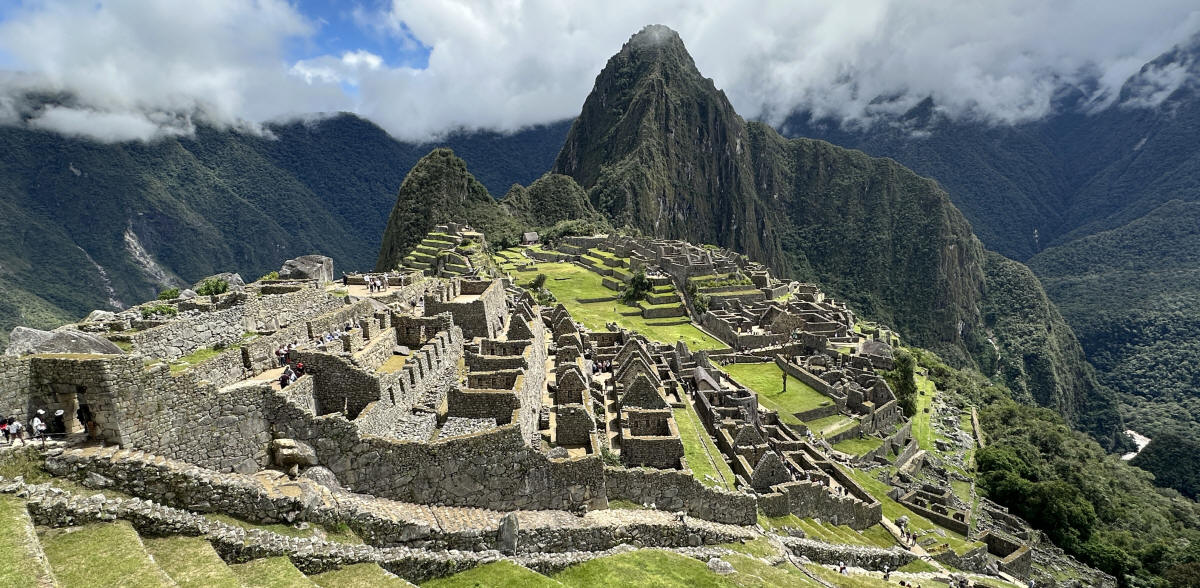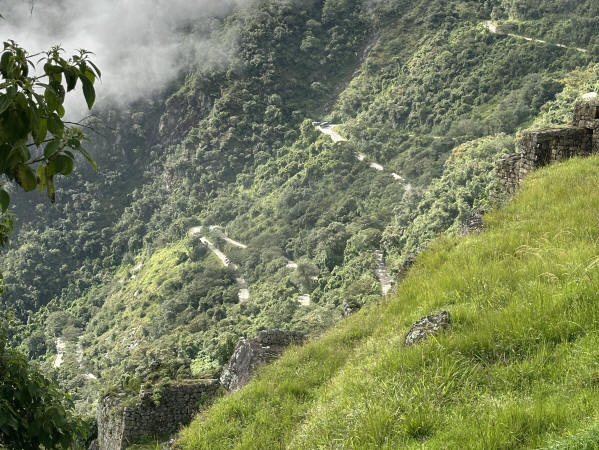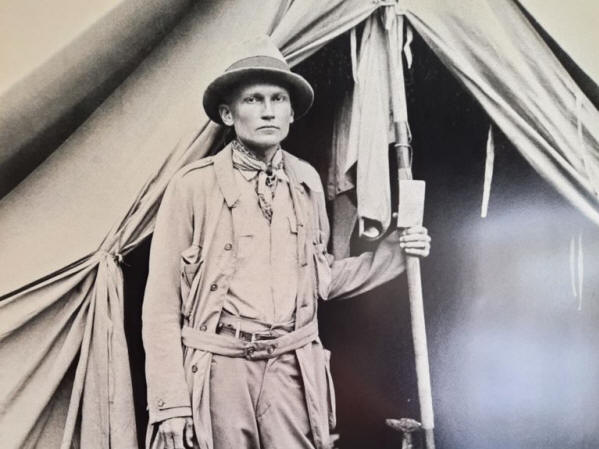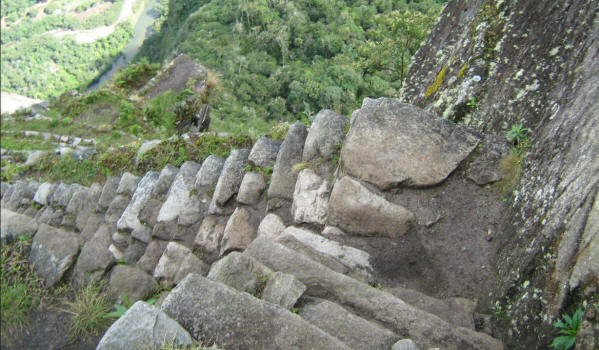
Summary: Bucket list item, checked.
Longer version: I really don't know exactly why some things capture a person's imagination, some kind of resonance with something you read, saw, or heard. Maybe in a past life. But Machu Picchu has always been on the list of things I wanted to see before I died moved on to the great unknown. It's a bit of a schlep to get to.
And it was totally worth it.
We were incredibly lucky on the trip, since this was the cornerstone of a two week exploration of South and Central America, and (a) it was between our separate food poisoning incidents and (b) it rained the night before the visit.
The rain probably needs a little more explanation. We had one of the small number of tickets (you have to book it at least six months in advance) for climbing the stairs of death, which are carved into the mountain overlooking Machu Picchu (pictured in the photo above). I should probably add that the name is a bit of hyperbole; very few people actually DIE on the stairs of death, a tad disappointing, but it still seemed like something you should do for a once-in-a-lifetime opportunity. At the time we were planning the trip, all we really knew about it was that it was a climb up a mountain overlooking the ruins, about a thousand vertical feet, theoretically strenuous, but not really "deadly." And we did about the same in the Grand Canyon last year, so it didn't seem like that much of a stretch.
But it turns out the Grand Canyon was spread out over three miles, whereas the stairs of death was the same elevation change over about a half a mile.
It's unfortunate that if it rains, they close the stairs for a day because, you know, slippery conditions and STAIRS OF DEATH, not a great combination. But the good news was it was the prior day / evening, so it wasn't raining when we arrived for the early 7:00 AM entry, and so we had the relatively uncrowded "circuit three" path to ourselves, with the atmospheric foggy clouds-crashing-into-the-mountains views, and could do the entire thing at our leisure.
Oh, and we didn't actually have to climb the stairs of death. Probably not a bad thing.
But our luck doesn't stop there. There are three different "paths" through Machu Picchu, and they intersect at some points, and at the end of our super early access on circuit 3 we were shunted off on the "circuit 2" path because ... well, actually, don't know, it just was.
But our normal, guided tour was circuit two, which has the iconic overview of Machu Picchu, and not only did the foggy, cloudy weather clear so we had perfect visibility, when we reached the point where it and circuit three intersected... we were shunted off on the circuit three path, so we had completely different paths through Machu Picchu.
It was AWESOME.
But I'm getting a bit ahead of myself. We should start with getting there the day before.
|
|
|
There's no road to Machu Picchu. You have to take a narrow gauge train for a couple of hours, paralleling the only other way to get there, the four day Inca Trail hike (which we might have tried if I was retired, but didn't have the time for; interestingly enough, Machu Picchu has a sister city that is larger, Choquequirao, which is only accessible by a four day hike through the jungle ... next time!). The train ride is tons of fun because it's running along a raging river (the Vilcanota) through the Andes, passing farms and Inca ruins along the way. And you're allowed to go out and stand on the back and watch it go by.
Incredibly picturesque. Then you pull into Aguas Calientes (there are no other stops along the way), which is built into the foothills below Machu Picchu, which makes it also incredibly picturesque.
We stayed overnight in a hotel (in theory, you can do Machu Picchu in a day without staying overnight, but it's a long, long day). The next day, we took one of a stream of busses up the switchback road up the mountain side. Which lead me to ask an obvious question and get an obvious answer ... if there's no road to Machu Picchu, how did the busses get there? And the answer was on the train. Duh.
Sometimes the switchbacks were so severe that you could spit out the window onto the next bus that was passing below you. If they let you do that, which as it turns out, they do not.
 |
We arrived around 7:30, and while we took what was in theory one of the earliest buses available, there was already a long line for circuit 1 and 2. Zero line for Circuit 3, because it doesn't give you the iconic view of Machu Picchu and is typically used to get to the stairs of death rather than a pure Machu Picchu tour. But even the lower path winds it way through the ruins, and it's the first time you get a sense of how large Machu Picchu really is. The iconic picture really doesn't do it justice.
Adding to the we-are-so-lucky moment, the rain clouds from the prior evening where still moving through the mountains, giving the views of the ruins and the surrounding mountains a cool atmospheric feel that's hard to describe or even really capture in pictures.
In the picture above, you can see the crowds on circuit 1 and 2 that we managed to avoid during our morning visit. So, I took about a thousand pictures but this isn't supposed to be a book, so we'll move on and I'll just throw in shots from both passes through Machu Picchu. After doing Circuit 3, which took about an hour and a half, we exited (on the Circuit 2 exit path) and waited for our guide, who showed up half an hour later. Then we re-entered the Circuit 2 gate, which gives you the famous overlook of the ruins. By that time, the clouds had cleared and we had perfect views of the ruins below. It was more crowded that the circuit 3 hike, but the crowds actually seemed to have died down a bit from the morning rush.
We did get a good look at Huayna Picchu Mountain and the stairs of death (photo of the actual stairs grabbed off the internet as the gate was locked). You climb to the terraces you can see at the top of the mountain.
|
So, again, so many photos, so little time. Here are a few highlights, including some Chinchillas that were hiding out in the ruins (you can see all the photos here if you want). There's a lot of things we were told about Machu Picchu but most of them were guesses, and some of them where multiple choice... there was one carved rock the guide said could be a sun dial, a astronomical instrument, a sacrificial altar, or just a stone that happened to be sitting near some of the buildings. If you look it up on Wikipedia, it pretty much says the same thing... "no one really knows." So I won't give you the history (other than, at the end, a little about the excavation in 1912 led by Yale Professor Hiram Bingham).
Post Machu Picchu, we visited a museum in Cusco holding artifacts and mummies from the site. Oddly enough, the vast majority of them, shipped off by Hiram Bingham to the US, are in the Peabody museum (the Yale one, not the Harvard one). But about a third of those were repatriated to Peru, and some of those ended up in Museo Machu Picchu - Casa Concha. They didn’t allow photos (no idea why), so I had to grab some off the internet. The last picture is a picture of a picture of Hiram Bingham, by the way, who wasn't an archeologist and so made a number of mistakes but kind of made up for it by taking a ton of photos while they were clearing the site.

 |
 |
And so ended our very awesome expedition to Machu Picchu (but we still had Panama ahead of us). Except for visiting the Peabody museum, which we will need to do at some point!
